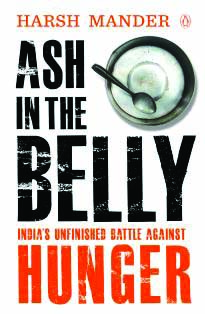Reviewed by Ghazal Zulfiqar
A boy eating bread in a slum in Mumbai — AFPHarsh Mander’s new book, Ash in the Belly: India’s Unfinished Battle Against Hunger, is once again a work of passion, unwavering compassion and
undeniable authority. Mander’s long list of credentials would convince anyone of his mastery over the subject matter: he is a writer, social worker, scholar, teacher, and a commissioner to the Supreme Court of India in the Right to Food case and has worked for more than two decades in the Indian administrative service. His love for the people he writes about is painfully clear as he weaves tale after tale of men and women who battle with hunger on a daily basis and teach their children to live with a constantly unsated belly.
We are brought so close to the lives of the people Mander meets on his travels across India that we can smell the dung the women in a hamlet in eastern Uttar Pradesh sift through to find undigested bits of grain they later wash and feed to their hungry children; we can feel the monsoon rain pelting down on the homeless men, women and children on the streets of Patna as they try to take cover under the closed shutters of shops; and we can hear the wails of the hundreds of hungry children across India who must sleep night after night with nothing more than sips from a pot of pale starchy water, with a few grains of rice floating in it.
This book is about the political economy of hunger in India, but is written in such an engaging manner that you don’t realise the important lessons you have learnt by the time you have finished reading it. Ash in the Belly describes how, despite years of spectacular economic growth and achieving self-sufficiency in grain production, hunger in India is not only persistent but also intergenerational. Mander suggests multiple reasons for this, including the arbitrary manner in which government surveys attempt to identify those who can be eligible for food subsidies; a corrupt distribution system that leads to leakages of nearly 39 percent; and a culture of subversion of minorities including Dalits, Muslims, leprosy patients, women and female children.
Mander describes how hunger is not just limited to the physiological dimension of an unappeased belly and chronic fatigue, but is also characterised by psychological and social deprivation that comes from loneliness, shame and low self-esteem. The poor and the hungry have to learn to live in a permanent state of destitution, and to do so they eat food shunned by others, such as the poisonous herbs that grow in the wild, or beg for stale leftovers or starch water left over from boiling rice in richer households, or in extreme cases by selling their children in order to keep them and the ones left behind alive. The stories in Mander’s carefully documented narrative have characters with names and real stories to tell, but we do not need these to tell us that this is not a fabricated reality.
The data Mander references is one proof of the sad state of Indian poverty and hunger. For instance, he informs us that 42 percent of Indian children under the age of five are underweight and 48 percent stunted. Further, we are told that more than 27 percent of the world’s undernourished population lives in India. These are damning figures that fly in the face of some very influential scholarship, such as that presented in the book Poor Economics written by MIT professors Abhijit Banerjee and Ester Duflo, who argue that people living on less than a dollar a day do not appear to be starving because if they were they would be spending every penny of their household budgets on food, but instead in countries like India, they seem to spend a good portion of their money on festivals and funerals. They also argue that since Indian survey data suggests that the percentage of people who say they do not get enough to eat has dropped from 17 percent to 2 percent between 1998 and 2004, it must be that people in India are just not eating more because they are less hungry.
Mander goes behind this data to describe how the surveys Banerjee and Duflo quote do not even touch the core of the problem because Indian government officials are unable to come up with an adequate definition of poverty. Thus, the question of how many are poor or hungry is irrelevant because they have not been able to figure out precisely who is poor. Mander’s suggestion is to ask the best experts on poverty and hunger — the poor themselves — to come up with a reliable definition of poverty, rather than leaving it up to the government.
Ash in the Belly is more than just a book about hunger; it is also an authoritative and in-depth analysis of the nature and complexity of poverty. It explains how the mechanics of rural and urban poverty are different but equally painful. It paints a vivid picture of the condemnation meted out to Dalits, leprosy patients and other social outcasts. It allows us to understand just how discrimination is meted out against women, including the practice of female infanticide and selective abortion, which the Nobel Laureate Amartya Sen has said is a major contributor of the 100 million “missing women” phenomenon. Finally, it provides an in-depth analysis of governance failure, which is characterised by indifferent legislation, such as fixing minimum wages at barely subsistence levels; corruption and cronyism; and a long tradition of failing to implement the laws that have been passed.
This book provides an instructive and universal lesson to those that wish to get a closer look at the nature of poverty, hunger and deprivation not just in India, but also the rest of the developing world. But it is also a must-read for those that are fortunate enough to have never had to live a life of poverty, or who have never had to watch their children cry themselves to sleep with empty bellies, or who do not have to bear the contempt, indifference and disregard of the well-fed and the well-off.
The reviewer is a PhD candidate at the University of Massachusetts Boston and teaches courses on economic development and global poverty
Ash in the Belly: India’s Unfinished Battle Against Hunger(Economics)
By Harsh Mander
Penguin Books, India
ISBN 9780143419587
368pp.















































